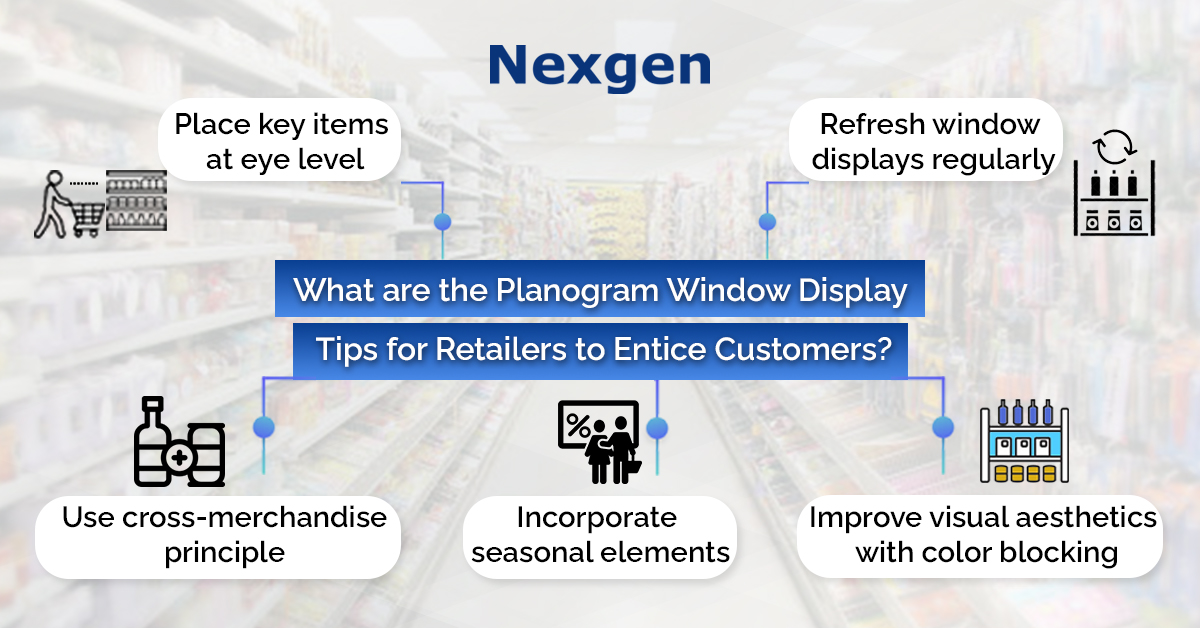Have you ever walked through a store and notice products being displayed in a store window that made you enter the store? If you have, this is one of the simplest ways that retailers use to entice customer’s attention with window displays.
Retailers use window displays as a sales strategy to attract customers to visit a store. That is why retailers use their store’s exterior parts, like window displays, to allow customers to come into the store and check out the products. If the exterior of the store is gloomy, no customers will come and visit your store. Every brick-and-mortar store should have creative and aesthetic window displays to increase foot traffic. A planogram is used to design and execute store displays to drive in-store sales. Planogram is a visual merchandising tool, that helps to ensure proper product placement on store displays to generate more sales. Important planogram ideas to maintain a proper window display are as follows:
- A retailer should choose engaging colors, décor and types of products that he wishes to display on a window display.
- Displaying cross-merchandise items on window displays will increase the basket size and entice customers.
- The retailer can use discount labels on window displays to captivate the shopper’s attention, and this will help to drive in-store sales.
What are the Planogram Window Display Tips for Retailers to Entice Customers?
In brick-and-mortar stores, a store’s visual aesthetics are what makes people walk into your store in the first place. That is why, your store’s window displays play a big part in visually appealing customers. A retailer can choose the following planogram window display ideas to entice customers:

- Know your target audience: Every retail business has its own target customers, and knowing them better is one of the first things a retailer should take care of. The retailer should visually appeal to their target customer without forgetting the potential customer. This means, he should understand what their needs, what is important to them, and accordingly create window displays that satisfy those desires. For example, each fashion apparel store knows that its primary target audience is women and bringing dresses that suits their unique fashion style and needs can make them revisit your store often.
- Place key items at eye level: There is a need to identify the key products of window display and position them at eye level. This will help to draw customer’s attention and will make them to have a second glance at the products. For example, your key product is jewelry or an outfit, placing them at eye level increases the likelihood of capturing customer’s attention and draws them inside your store.
- Refresh window displays regularly: Changing the window displays frequently will increase store sales and customer attention. Due to the repeat walk-by-traffic, old and outdated displays get ignored by a large audience. Constantly changing such displays can get customer’s attention and draws them inside the store. Displays can be changed with the help of planogram on a monthly basis, or during seasons or holidays, or every week. For example, updating the window displays during the latest seasonal trends can bring in customers who wish to see the items that are in -style right now. This will increase foot traffic and impulse purchases.
- Use cross-merchandise principle: Displaying cross-merchandise products on window displays can help to brand and market the store. By placing products of different categories like clothing, accessories, bags or shoes next to each other, it can make customers purchase these products together and generate more sales.
- Incorporate seasonal elements: Window displays are the best way to advertise in-store displays that help to draw customers into the store. For instance, during the Christmas season, retailers can position products on window displays and make customers purchase or enter a store. This will help retailers to maximize their in-store sales.
- Improve visual aesthetics with color blocking: Retailers can improve the visual aesthetics of their window displays with the right color combinations. This will encourage store walk-ins and sales. For example, if the store is a kid's apparel, a retailer can use colors like blue, pink, yellow, and red to enhance the store’s visual aesthetic and entice customers.
Overview of Nexgen POG
Nexgen POG is a robust cloud-based visual merchandising tool designed for quick and easy planogramming. It is multi-device compatible software that helps retailers to create store-specific retail displays to boost in-store sales and increase revenue. Nexgen POG ensures the right product placement, proper category management and compliance analysis for improving retail store performance.
Get Your Free Trial Now!